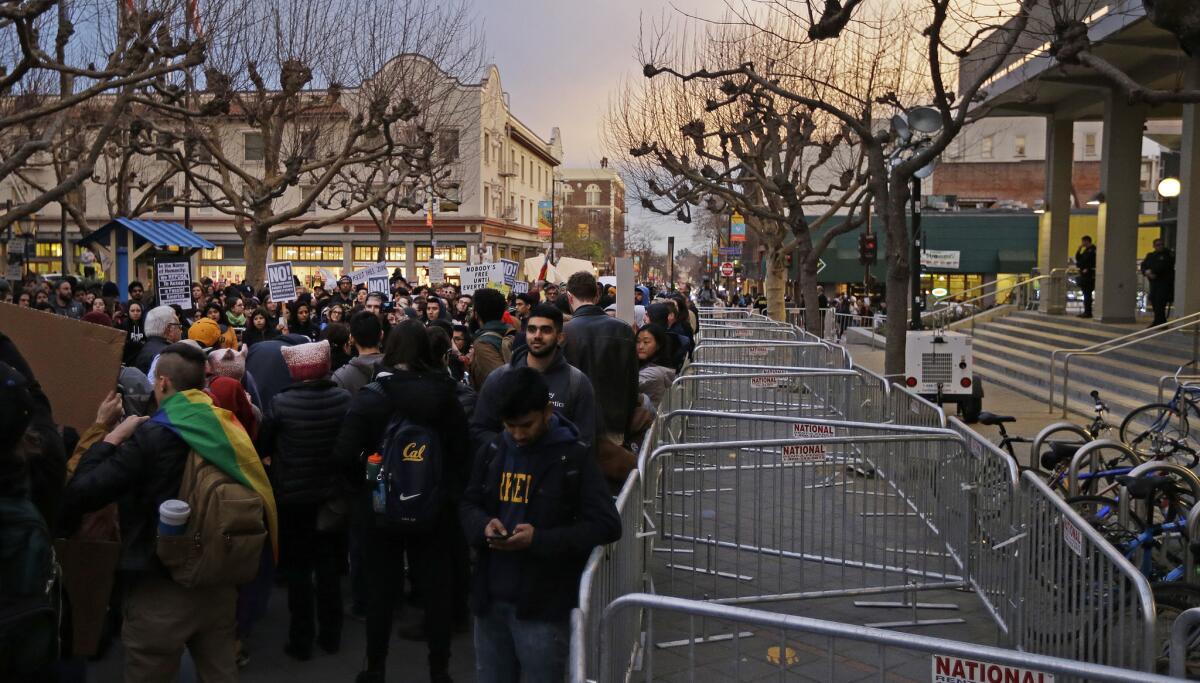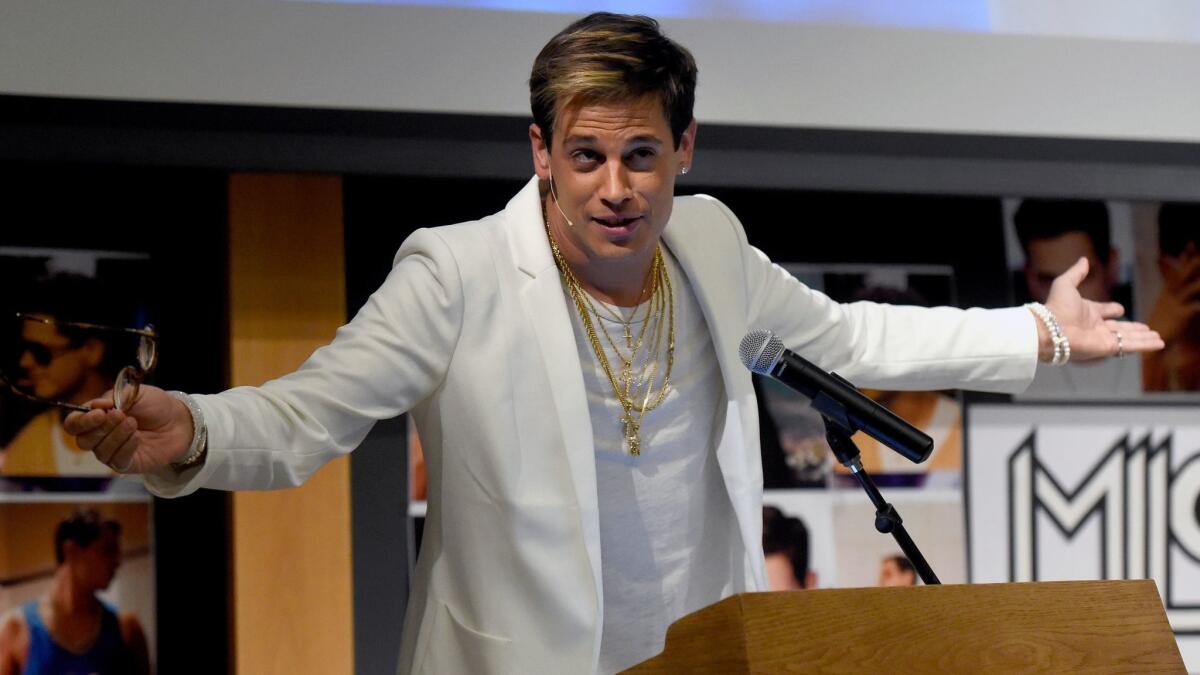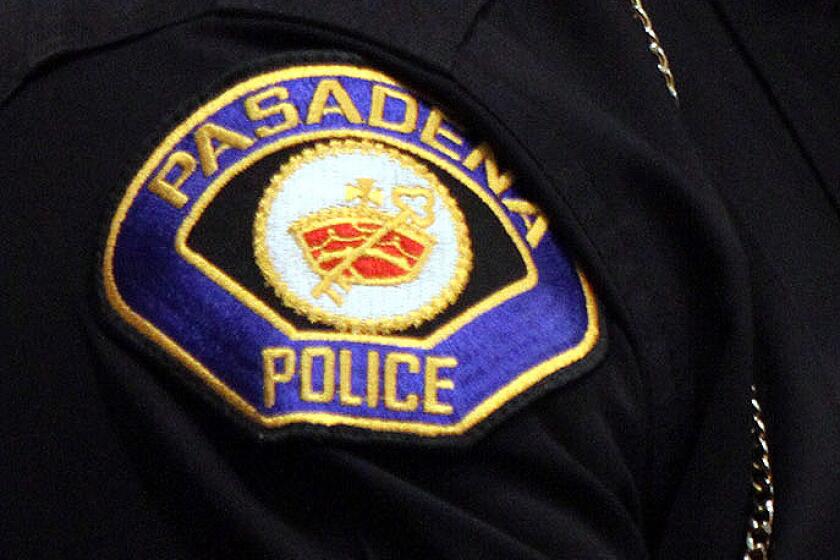Inside the black bloc militant protest movement as it rises up against Trump

The movement first made its presence felt in California more than two decades ago, then built its forces amid the protests against the Iraq war in San Francisco’s Financial District in 2003.
- Share via
Reporting from OAKLAND — The movement first made its presence felt in California more than two decades ago, then built its forces amid the protests against the Iraq war.
Out of the sea of largely peaceful antiwar demonstrators marching in San Francisco’s Financial District in 2003, a more militant subgroup emerged. Its members wore black masks, black jackets, black hoods and helmets. They smashed windows and looted military recruitment offices.
For the record:
9:50 p.m. June 28, 2019An earlier version of this story described It’s Going Down as an organization. It is a website.
Since then, the so-called black bloc protesters have become a force in the Bay Area and beyond. They have been blamed for violence during protests in Oakland over corporate power and police abuse, notably the case of Oscar Grant, an unarmed black man who was killed by BART police in 2009.
Scorned by critics on both the left and right and hunted by police, the black bloc is bringing its radical tactics to the massive protest movement sparked by the presidency of Donald Trump.
The masked militants went fist to fist with neo-Nazis at the state Capitol in June, where five of their allies were stabbed. Black bloc tactics also dogged Trump’s inaugural ceremonies in Washington, leaving broken windows, vandalized banks and a torched limo.
And early this month on the UC Berkeley campus, black bloc militants tore down police barricades, broke windows, started a fire and assaulted Trump supporters.
They represented a small percentage of the 1,000 mostly nonviolent demonstrators who went to Berkeley to protest a speech by controversial Breitbart columnist and conservative writer Milo Yiannopoulos, but they dominated the outcome.

The university had been determined to allow the event in the name of free speech. Within minutes of the bloc’s assault on the building where the speech would be held, officials shut it down.
The protests earned rebukes from students, university administrators and Trump.
The angry vice chancellor called the melee an “unprecedented invasion” of an otherwise peaceful protest.
But some leaders of the campus protest called it a smashing success.
“It wasn’t just people dressed in black who were acting militantly and everyone else is peace-loving Berkeley hippies,” said Yvette Felarca, a political organizer of By Any Means Necessary, an immigration and affirmative action coalition that seeks to build a mass militant movement.
“Everyone cheered when those barricades were dismantled. ... Everyone was there with us in political agreement of the necessity of shutting it down, whatever it was going to take. It shows we have the power,” Felarca said. “I thought it was quite stunning.”
::
The term “black bloc” was used to describe the tight wedges of black-clad protesters in helmets and masks who appeared in street demonstrations in Germany in the 1970s, confounding efforts to single out, identify and prosecute individuals.
I go through the Bay Area and there are people sleeping in the doorways of million-dollar condos that are empty. ... Is that not violent?
— Bay Area black bloc militant
Its aim was, and still is, direct action. Practitioners care little for speech or to shape public opinion, and the media are held in disdain, as are liberals who espouse nonviolence.
Members operate in small squads that organize themselves around flags during the havoc of a protest. Many are anarchists, and anarchist websites such as It’s Going Down provide a public platform for reports from the underground.
They say they battle police brutality, corporate greed, immigration bans and erosion of civil liberties. The Bay Area has provided a fertile base for the group, especially Oakland, birthplace to the armed militias of the Black Panther movement.
“I subscribe to self-defense in the very same sense that the Black Panther Party does and that Malcolm X does,” said a veteran Bay Area black bloc militant who spoke on the condition that he not be named because much of the group’s actions are illegal.
He described himself as an employed college graduate, the product of youth incarceration and a household where street respect — not pacifism — was preached.
“Which means for me to recognize one type of violence, which is people being beat up for having certain types of political views and being brazen about them, compared to the everyday violence ... like I go through the Bay Area and there are people sleeping in the doorways of million-dollar condos that are empty. ... Is that not violent?” he said. “That is the most cruel and violent thing I think I have ever seen.”
The UC Berkeley protest was a call to arms for him and others. For months, protesters on campuses across the country have sought to shut down Yiannopoulos’ provocative college shows, in which he ridicules transgender people, immigrants who are in the country illegally and others.
Yiannopoulos, permanently banned from Twitter for racist and misogynist posts, denies allegations he is a white supremacist.

In the weeks leading up to the Berkeley event, campus administrators made clear their intent to allow the controversial speaker, part of a larger state university system’s adoption of the ACLU mantra to “combat hate speech with more speech.”
After a Yiannopoulos supporter shot a protester during demonstrations in Seattle, UC Berkeley responded to the rising threat of violence by pulling in officers from nine other campuses.
They stayed inside the barricaded Student Union building during most of the protest, arguing that to intervene would have escalated the violence. The effect instead was to raise the ante for the black bloc.
“They were going to allow it to happen until they determined that it was too dangerous for it to actually happen,” the black bloc member said. “So what other choice did we have?”
Berkeley put the blame for the violence at the Yiannopoulos event squarely on the black bloc faction, which campus police said numbered 100 to 150 members.
They “marched onto campus and began immediately throwing rocks, M-80s flares and Molotov cocktails at our officers and the crowd,” UC Berkeley Police Department Sgt. Sabrina Reich said.
Videos show black bloc members using firecrackers as a shield to get close to the Student Union, where they pulled down barricades. They took turns whacking at its windows with their sticks, rocks and the crowd-control barriers themselves. The bulk of the blows were directed at the Amazon store.
Videos also show black bloc members tackling and assaulting Yiannopoulos supporters.
There is a strategy behind much of the smashing, according to interviews and published manifestos.
The bloc pushes back against police lines, opening and holding space for mass demonstrations as police seek to corral and disperse the crowd. They draw pepper spray, rubber bullets and other uses of force. They say they focus destruction on standard-bearers of capitalism: Bank machines and a campus Starbucks were hit after Berkeley called off the Yiannopoulos speech.
“Starbucks is a symbol of global capitalization,” the black bloc member said.
Those activists interviewed expressed no remorse for the property damage. They said it should pressure the university to think twice about allowing such events in the future. They hold the same regard for violence against people.
Bloc activists accompanying demonstrators against a white nationalist rally at the Capitol in Sacramento in the summer were met by white supremacists armed with knives.
Two law enforcement agencies continue to investigate the June 26 clash. Five people were stabbed, all on the side of the antifa, the anti-fascist movement. One was Felarca, who said assailants used box cutters and knives taped to their protest sticks. She required 24 stitches in her arm and head.
Sacramento police said they had been warned about the intent for violence, but they felt unable to stop it and after the fact, thwarted from investigating.
Within the anti-fascist movement, blog posts admonish wounded protesters not to speak to police.
Felarca and other activists said there is no official coordination with the black bloc, but there is covert communication between longtime street allies. Sometimes it is broadcast to the world, such as Facebook event invitations that call for participants to bring bandannas and other safeguards against pepper spray.
But they do recruit. An anarchist group is hosting a two-day conference in Oakland and San Francisco next month to draw newcomers. The black bloc member said he hopes it will help more people find the movement.
“The people I see coming in are curious about what this direct politics looks like. They have come up in the post-Oscar Grant, post-Occupy sort of political environment,” the member said. “In the next few years, they’re going to get their wings and they’ll start flying.”
Twitter: @paigestjohn
ALSO
Immigration arrests heighten fears in Southern California as hoaxes, false rumors swirl
Trump hints at cutting federal funds to UC Berkeley after violent protests over Milo Yiannopoulos
BART rail system may designate itself a ‘sanctuary in transit’
More to Read
Sign up for Essential California
The most important California stories and recommendations in your inbox every morning.
You may occasionally receive promotional content from the Los Angeles Times.










